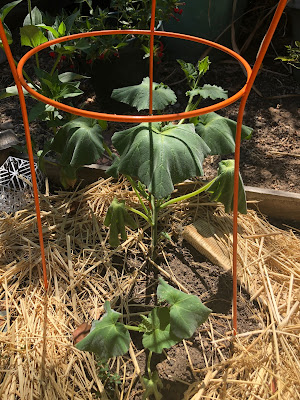Prepare the garden for the dangerous heat wave ahead
 |
Frost cloth attached to hoops protects this gardener's strawberry and melon plants from intense sunlight. (Photos: Kathy Morrison) |
By Kathy Morrison
The forecast for the next week in Sacramento is terrifying: Eight days of triple digits, including at least six days at 107 degrees or higher. The National Weather Service has issued an excessive heat warning, in effect from noon Friday through 9 p.m. Wednesday for the Central Valley and foothills.
The forecast for the next week in Sacramento is terrifying: Eight days of triple digits, including at least six days at 107 degrees or higher. The National Weather Service has issued an excessive heat warning, in effect from noon Friday through 9 p.m. Wednesday for the Central Valley and foothills.
Remember that our top temperature so far this summer was 106 degrees, on July 11-12, and that seemed brutal. That heat spike also was over fairly quickly.
How can a gardener prevent or at least mitigate heat stress and keep plants alive?
Do this:
1) Water -- This is your first and best defense for your plants. Make sure they are well watered before the day's heat kicks in. You may have to water daily -- preferably in the early morning hours -- until temps return to normal. But be sure to check the soil frequently, too. You don’t want to drown your plants, either.
And if you have a drip system, check along its length to make sure all the emitters are working properly. Discovering one is clogged after a nearby plant has died is just sad.
How can a gardener prevent or at least mitigate heat stress and keep plants alive?
Do this:
1) Water -- This is your first and best defense for your plants. Make sure they are well watered before the day's heat kicks in. You may have to water daily -- preferably in the early morning hours -- until temps return to normal. But be sure to check the soil frequently, too. You don’t want to drown your plants, either.
And if you have a drip system, check along its length to make sure all the emitters are working properly. Discovering one is clogged after a nearby plant has died is just sad.
And when you're done watering the roots, give the plants a light water spray on the leaves, too. It'll clean off the dust and freshen up the plants.
Container plants, whose roots are more exposed to heat, may require watering twice a day.
And if you haven't deep-watered your trees at least once this summer, this weekend would be the time to do it. Micro-sprayers work best with trees, but a soaker hose spiraled around the root zone also works well. Give your precious shade trees a long, slow soak and they'll be better-equipped to handle the heat, too.
2) Mulch -- Two to 4 inches of mulch is the ideal, and not too close to trunks or stems, please. This slows evaporation of the water you just gave the plants. Compost makes terrific mulch because it will enhance the soil eventually, as well as keep it moist now. Other organic options include straw, wood chips or shredded newspaper.
3) Harvest -- Seriously, harvest whatever you can now. This prevents heirloom tomatoes from exploding in the heat, for example, and eases the stress on any crop plants. (By the way, you have probably learned by now that tomato and squash plants droop in the afternoon heat, as a protective measure. If they droop in the morning, they need water and possibly some attention.)
 |
These butternut squash plants will perk up again overnight. |
5) Relocate -- If you can move container plants to a shadier spot, do so. You can always move them back later. No one’s going to be outside to comment on your pot lineup under the eaves anyway.
6) Insulate -- Some containers are just too big to move. Or maybe you don’t have any shadier spots. But you should try to keep the roots of container plants from cooking in their pots. One way is to set a small pot inside a large empty one that has been lined with crumpled paper. Another method is to push several containers together, so they shade and insulate each other. A group of containers also is easy to shade with old sheets or beach towels.
But don’t:
1) Fertilize -- Fertilizing a plant in a heat wave is a good way to stress your plant, foster weak new shoots and attract pests.
2) Trim off burned/brown leaves -- This is the same advice for plants after a freeze. Those mostly dead leaves on the outside will have to go someday, but for now they're protecting the leaves underneath. So leave them alone.
3) Plant or transplant -- Again, who wants to add to a plant's stress? If you bought new plants, keep them in the shade and keep them watered until temps are normal again. And avoid buying any more until September, since fall is a better time to plant, anyway.
And for the gardener:
Stay hydrated, and stay inside as much as possible. Getting heatstroke doesn't help the plants or yourself.



Comments
Post a Comment